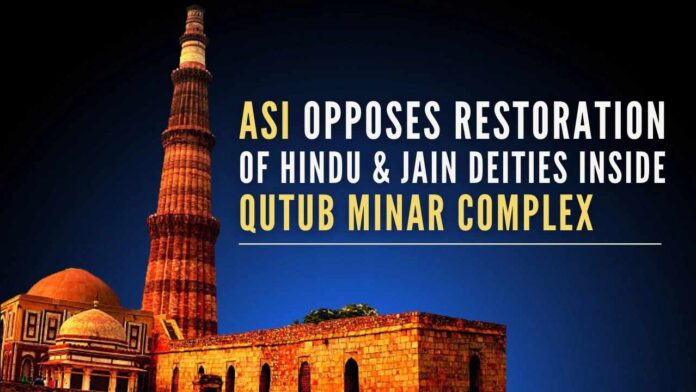
Delhi court reserves order on plea to restore temples claimed to be inside Qutub Minar complex
The Government of India’s Archaeological Survey of India (ASI) on Tuesday opposed a plea before a Delhi court seeking restoration of Hindu and Jain deities inside the Qutub Minar complex, saying it is not a place of worship and the existing status of the monument cannot be altered. The ASI also said that it would be contrary to the law to agree to the contention of any person claiming a fundamental right to worship in this “centrally protected” monument. This deposition from ASI under the BJP ruled Central government came as a shocker to many of the party’s hard-line supporters. Additional District Judge Nikhil Chopra reserved the order on the plea for June 9.
Meanwhile, in the evening, Delhi Waqf Board has claimed that namaz used to be offered at a mosque there, which was stopped by the Archaeological Survey of India. Delhi Waqf Board chairman Amanatullah Khan (who is also MLA of AAP) in a letter to ASI Director-General, last week, requested for allowing namaz at the “ancient” Quwwat-ul-Islam mosque in Qutab Minor complex, claiming it was stopped by the ASI officials.
The ASI, however during the court argument admitted that the architectural materials and images of Hindu and Jain deities were re-used in the construction of the Qutab complex. “Fundamental right cannot be availed in violation of any status of the land. The basic principle of protection conservation is not to allow starting of any new practice in a monument declared and notified as a protected one under the Act,” the ASI said.
The ASI said that revival of worship was not allowed wherever it was not practiced at the time of protection of a monument. “Qutab Minar is not a place of worship and since the time of its protection by the Central government, Qutab Minar or any part of Qutab Minar was not under worship by any community,” it said. The counsel for the ASI further said that it was very clear from the Persian inscription at the Quwwat-ul-Islam mosque, that the cloisters were erected with carved columns and other architectural members from 27 temples.
“Inscription is clear that the mosque was built with the remains of these temples. But nowhere it is mentioned that the materials were retrieved by demolishing temples. Also, it is not clear if they were retrieved from the site or brought from outside… Not demolished but remains of temples used for construction,” the counsel said. He added that there was no provision under the Ancient Monuments and Archaeological Sites and Remains (AMASR) Act under which worship could be started at any living monument.
“The intention of the statute is clear that the monument should be protected and preserved in its original condition for the posterity. Therefore, changing and alteration of the existing structure would be a clear violation of the AMASR Act and thus should not be allowed,” the ASI counsel said. He added that as per the petitioner’s submissions, for 800 years the monument was in the same condition. “It is only recently that these things are coming up,” he said.
During the hearing, the court observed that in the south-India, there are many monuments that are not being used and prayers are not being offered. “Now you want the monument to be turned into a temple. My question is how you claim a legal right for restoration for something which happened 800 years ago,” the judge asked.
The judge said that the main issue was the “right to worship”. “What is the backing of this right? Idol exists there or not is not the case,” the judge said. During the hearing, the ASI also submitted that when the complex was constructed, materials were used in a haphazard manner resulting in images being erected upside down in some places. One image of Lord Ganesha is on the lower portion of the wall and is stated to have been protected with a grill to prevent any possibility of someone steeping on it.
Another image of Lord Ganesha is found in the complex in an upside-down position. However, this is embedded in the wall, therefore, it is stated that it may not be feasible to remove or reset the same. The court was hearing a plea filed against an order of a magisterial court, which had dismissed a suit filed by advocate Hari Shankar Jain on behalf of Jain deity Tirthankar Lord Rishabh Dev, claiming that 27 temples were partly demolished by Qutubdin Aibak, a general in the army of Mohammad Gauri, and Quwwat-ul-Islam Mosque was raised inside the complex by reusing the material.
Jain stated that there were two idols of Lord Ganesha, situated on the premises since times immemorial and that he apprehended that the ASI was likely to remove them to one of the National Museums as mere artifacts. After the long arguments from both sides and the Government side (ASI) Judge reserved for orders on June 9.
[with PTI inputs]
PGurus is now on Telegram. Click here to join our channel and stay updated with all the latest news and views
For all the latest updates, download PGurus App.
- NIA confiscates Pak-harboured Khalistani terrorist Lakhbir Singh Rode’s key aide’s land in Moga - April 19, 2024
- Prime Minister Narendra Modi: A Gujju businessman who does not invest his precious time for a losing battle - April 13, 2024
- NIA arrests two accused Shazib and Taahaa in Bengaluru’s Rameshwaram Cafe blast case from Kolkata - April 12, 2024










